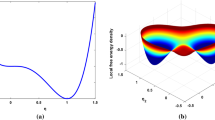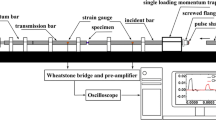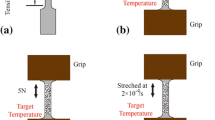Abstract
Shape Memory Alloys (SMAs) such as NiTi exhibit stress induced martensitic phase transformation. The purpose of this paper is to provide a better understanding of SMA (such as NiTi) fracture behavior, by considering the vicinity of the crack tip where the transformation occurs. This analysis integrates the asymmetry between tension and compression in an analytical prediction of the surface of phase transformation around the crack tip for loading modes 1, 2, 3 and mixed 1+2. The influence of the asymmetry between tension-compression is more important in plane stress conditions than in plane strain conditions, particularly for mode 1 loading. In order to validate this model, we are currently setting up an experimental investigation to observe strain localization during crack propagation (transformation and martensitic saturation regions) on NiTi thin sheets.
Similar content being viewed by others
References
Bouvet C, Calloch S, Lexcellent C (2004) A phenomenological model for pseudoelasticity of shape memory alloys under multiaxial proportional and nonproportional loadings. Eur J Mech A/Solids 23(1): 37–61
Daly S, Miller A, Ravichandran G, Bhattacharya K (2007) An experimental investigation of crack initiation in thin sheets of nitinol. Acta Mat 55: 6322–6330
Freed Y, Banks-Sills L (2007) Crack growth resistance of shape memory alloys by means of a cohesive zone model. J Mech Phys Solids 55(10): 2157–2180
Gibeau E, Laydi MR, Lexcellent C (2010) Determination and transport of phase transformation yield surfaces for shape memory alloys. J Appl Math Mech/Zeitschrift für Angewandte Mathematik und Mechanik (ZAMM) 90(7): 595–604
Laydi MR, Lexcellent C (2010) Yield criteria for shape memory materials: convexity conditions and surface transport. Math Mech Solids 15(2): 165–208
Lexcellent C, Thiebaud F (2008) Determination of the phase transformation zone at a crack tip in a shape memory alloy exhibiting asymmetry between tension and compression. Scripta Mat 59(3): 321–323
Miyazaki S, Kimura S, Takei F, Miura T, Otsuka K, Suzuki Y (1983) Shape memory effect and pseudoelasticity in a Ti-Ni single crystal. Scripta Mettalurgica 17: 1057–1063
Panoskaltsis VP, Bahuguna S, Soldatos D (2004) On the thermomechanical modeling of shape memory alloys. Int J Non-Linear Mech 39(5): 709–722
Patoor E, Lagoudas DC, Entchev PB, Brinson LC, Gao X (2006) Shape memory alloys, part I: general properties and modeling of single crystals. Mech Mat 38(5–6): 391–429
Raniecki B, Lexcellent C (1998) Thermodynamics of isotropic pseudoelasticity in shape memory alloys. Eur J Mech A/Solids 17(2): 185–205
Robertson SW, Ritchie RO (2007) In vitro fatigue—crack growth and fracture toughness behavior of thin-walled superelastic Nitinol tube for endovascular stents: a basis for defining the effect of crack-like defects. Biomaterials 28(4): 700–709
Robertson SW, Mehta A, Pelton AR, Ritchie RO (2007) Evolution of crack-tip transformation zones in superelastic Nitinol subjected to in situ fatigue: A fracture mechanics and synchrotron X-ray microdiffraction analysis. Acta Mat 55(18): 6198–6207
The Society of Materials Science, Japan, Editor-in-chief Murakami Y (1987) Stress intensity factors handbook, vol 1. Cracks in an infinite plate, 1st edn. Pergamon Press, NY, p 188
Thiebaud F, Lexecllent C, Collet M, Foltête E (2007) Implementation of a model taking into account the asymmetry between tension and compression, the temperature effects in a finite element code for shape memory alloys structures calculations. Comput Mater Sci 41: 208–221
Vacher P, Lexcellent C (1991) Study of pseudoelasticity behavior of polycrystalline shape memory alloys by resistivity measurements and acoustic emission. In: Jono M, Inoue T (eds) Proceedings of ICM VI, vol 3. Pergamon Press, NY, pp 213–236
Wang XM, Wang YF, Baruj A, Eggeler G, Yue ZF (2005) On the formation of martensite in front of cracks in pseudoelastic shape memory alloys. Mat Sci Eng A 394(1–2): 393–398
Yi S, Gao S (2000) Fracture toughening mechanism of shape memory alloys due to martensite transformation. Int J Solids Struct 37(38): 5315–5327
Author information
Authors and Affiliations
Corresponding author
Rights and permissions
About this article
Cite this article
Lexcellent, C., Laydi, M.R. & Taillebot, V. Analytical prediction of the phase transformation onset zone at a crack tip of a shape memory alloy exhibiting asymmetry between tension and compression. Int J Fract 169, 1–13 (2011). https://doi.org/10.1007/s10704-010-9577-3
Received:
Accepted:
Published:
Issue Date:
DOI: https://doi.org/10.1007/s10704-010-9577-3




